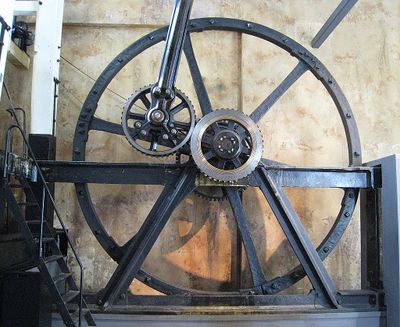Rotational kinetic energy: Difference between revisions
J.williams (talk | contribs) m (1 revision imported) |
No edit summary |
||
| Line 1: | Line 1: | ||
[[Category:Done | [[Category:Done 2018-07-20]] | ||
<onlyinclude>'''Rotational kinetic energy''' is the [[energy]] associated with spinning around on an axis. It's an energy of motion, just like linear [[kinetic energy | [[File:flywheel.jpg|thumb|right|400px| Figure 1. A flywheel will exhibit rotational kinetic energy.<ref>flywheel of the Boulton-Watt steam engine", Flickr, 2018. [Online]. Available: https://www.flickr.com/photos/newtown_grafitti/4803665199. [Accessed: 15- Jun- 2018].</ref>]] | ||
<onlyinclude>'''Rotational kinetic energy''' is the [[energy]] associated with spinning around on an axis. It's an energy of motion, just like linear [[kinetic energy]].</onlyinclude> | |||
Rotational kinetic energy depends on the | Rotational kinetic energy depends on: | ||
* How fast the object is spinning (faster spinning means more energy). | |||
* How much mass the spinning object has (more massive means more energy). | |||
* Where the mass is located compared to the spin (objects farther from the spinning axis have more rotational kinetic energy). | |||
< | ==Physical systems== | ||
Some physical systems where rotational kinetic energy is important include: | |||
* [[Flywheel]]s (Figure 1) and [[dynamo]]s which spin very fast and have a high moment of [[inertia]] in order to store energy. These have been proposed as possible [[energy storage]] devices. | |||
* [[Molecule]]s get rotational kinetic energy, which becomes part of their [[thermal energy]]; this can be seen in the molecule's [[heat capacity]]. | |||
* [[Turbine]]s are turning the energy in a fluid into rotational kinetic energy. This energy is then turned into [[electricity]] with a [[generator]]. | |||
* The Earth has rotational kinetic energy associated with going spinning around its axis once a [[day]] (roughly 38 Octillian [[Joule]]s).<ref>That's <math>3.8\times 10^{28}</math> joules, or 38 billion billion billion joules.</ref>) | |||
* The Earth has rotational kinetic energy associated with orbiting the [[sun]] once a [[year]] (roughly 2,700,000 Octillian Joules).<ref>That's <math>2.7\times 10^{33}</math> joules, or 2.7 million billion billion billion joules. Roughly 100,000x the amount of energy of the Earth spinning on its axis.</ref>) | |||
[[Flywheel]] | To learn more about rotational kinetic energy, please see [http://hyperphysics.phy-astr.gsu.edu/hbase/rke.html#rke hyperphysics]. | ||
==For Further Reading== | |||
*[[Kinetic energy]] | |||
*[[Inertia]] | |||
*[[Flywheel]] | |||
*[[Turbine]] | |||
*[[Thermal energy]] | |||
*Or explore a [[Special:Random|random page]] | |||
==References== | |||
{{reflist}} | |||
[[Category:Uploaded]] | [[Category:Uploaded]] | ||
Revision as of 17:07, 19 July 2018

Figure 1. A flywheel will exhibit rotational kinetic energy.[1]
Rotational kinetic energy is the energy associated with spinning around on an axis. It's an energy of motion, just like linear kinetic energy.
Rotational kinetic energy depends on:
- How fast the object is spinning (faster spinning means more energy).
- How much mass the spinning object has (more massive means more energy).
- Where the mass is located compared to the spin (objects farther from the spinning axis have more rotational kinetic energy).
Physical systems
Some physical systems where rotational kinetic energy is important include:
- Flywheels (Figure 1) and dynamos which spin very fast and have a high moment of inertia in order to store energy. These have been proposed as possible energy storage devices.
- Molecules get rotational kinetic energy, which becomes part of their thermal energy; this can be seen in the molecule's heat capacity.
- Turbines are turning the energy in a fluid into rotational kinetic energy. This energy is then turned into electricity with a generator.
- The Earth has rotational kinetic energy associated with going spinning around its axis once a day (roughly 38 Octillian Joules).[2])
- The Earth has rotational kinetic energy associated with orbiting the sun once a year (roughly 2,700,000 Octillian Joules).[3])
To learn more about rotational kinetic energy, please see hyperphysics.
For Further Reading
- Kinetic energy
- Inertia
- Flywheel
- Turbine
- Thermal energy
- Or explore a random page
References
- ↑ flywheel of the Boulton-Watt steam engine", Flickr, 2018. [Online]. Available: https://www.flickr.com/photos/newtown_grafitti/4803665199. [Accessed: 15- Jun- 2018].
- ↑ That's joules, or 38 billion billion billion joules.
- ↑ That's joules, or 2.7 million billion billion billion joules. Roughly 100,000x the amount of energy of the Earth spinning on its axis.

